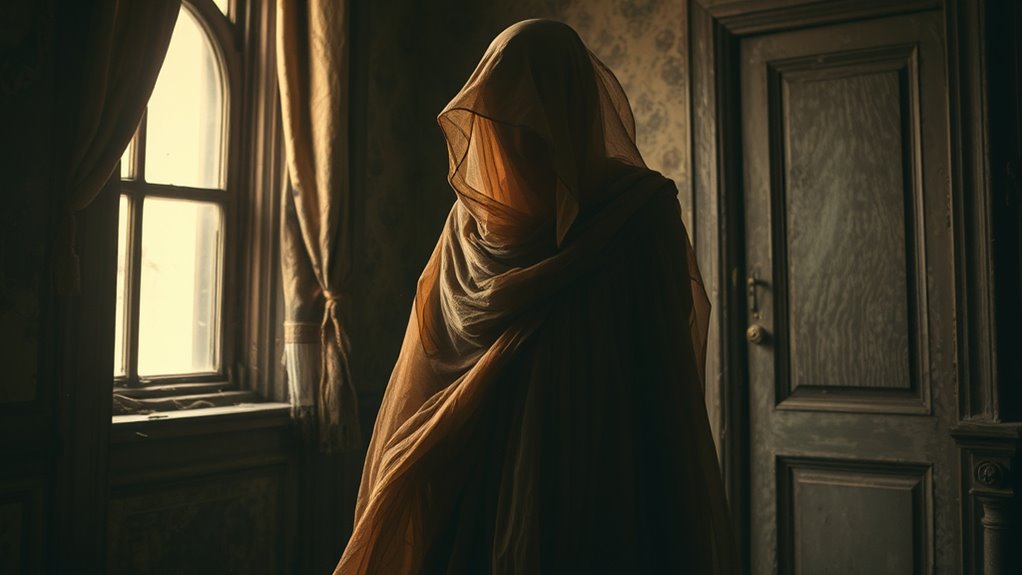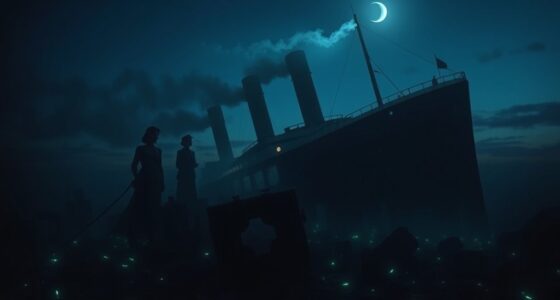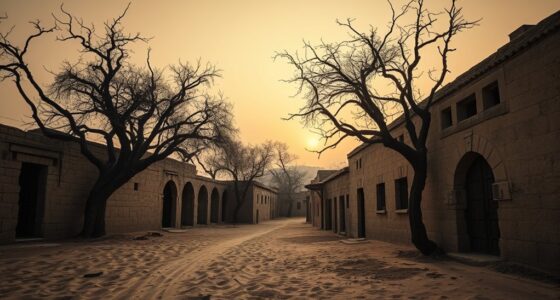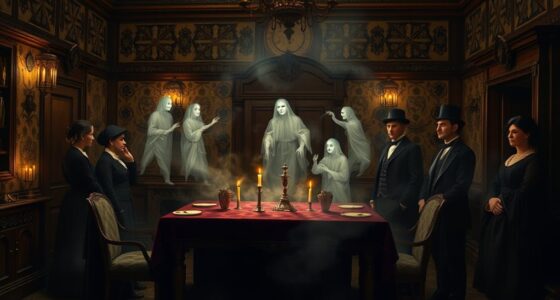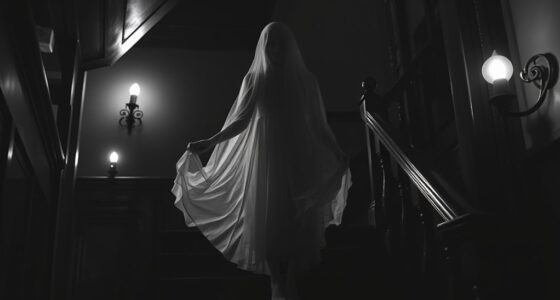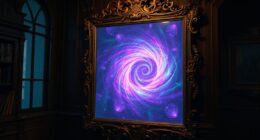The 1936 “Brown Lady” photograph was taken at Raynham Hall in Norfolk, England, famous for a long history of ghost sightings, especially a mysterious woman in brown. Eyewitness accounts and local legends preceded the photo, which was published in *Country Life* magazine, fueling paranormal debates. Experts suggest possible tricks like double exposure, but the story remains iconic in ghost lore. Continue exploring, and you’ll uncover more about its fascinating history and mystery.
Key Takeaways
- The 1936 photograph was taken at Raynham Hall in Norfolk, England, amid longstanding ghost sightings of a woman in brown.
- It was published in *Country Life* magazine, linking visual evidence with local paranormal legends.
- Prior sightings and folklore about the “Brown Lady” contributed to the photograph’s cultural significance.
- Experts suggest possible photographic manipulation, such as double exposure or optical illusions, casting doubt on its authenticity.
- The image remains a prominent piece of paranormal lore, symbolizing the intersection of eyewitness accounts and visual storytelling.
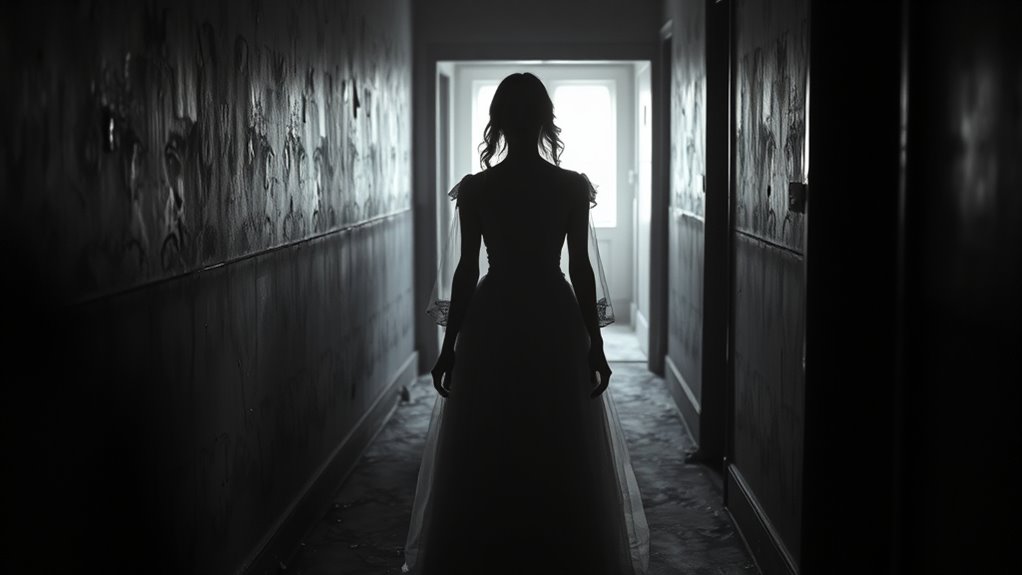
Have you ever wondered whether ghosts really exist? The Brown Lady photograph from 1936 is one of the most famous images that fuels such curiosity. It’s a picture that’s sparked countless debates about whether it captures a genuine apparition or is simply a clever hoax. To understand its impact, you need to consider the context surrounding the photo, especially the historical sightings associated with it and questions about its photographic authenticity. The image was taken at Raynham Hall in Norfolk, England, a stately house with a long history of ghost stories. Over the years, many visitors and staff reported strange sightings of a mysterious woman dressed in brown, often seen gliding through the corridors or appearing on the staircase. These accounts helped build a legend around the “Brown Lady,” making the photograph all the more intriguing. When it surfaced in a 1936 issue of *Country Life* magazine, it wasn’t just a picture; it was a visual piece of a story that had already permeated local folklore. Because of this, many saw the photo as a piece of evidence supporting the existence of spirits, especially given the long-standing historical sightings that predated the image. Yet, skeptics quickly questioned its photographic authenticity, pointing out that the image could have been manipulated or resulted from accidental camera exposure. Some experts suggest that the photograph was a double exposure or an optical illusion, common tricks used by early photographers. Others believe it was an elaborate prank, possibly staged to boost the house’s reputation as a haunted location. Despite these doubts, the image persisted as a compelling piece of paranormal lore, partly because of the credibility lent by the historical sightings. The story of the Brown Lady combines these elements: the ghostly reports from the past and the striking photograph that seemed to capture a supernatural entity. This blend of eyewitness accounts and visual evidence made the image legendary. Over time, the photograph has been scrutinized with modern technology, with some tests suggesting it could be authentic, while others reinforce doubts about its origins. But what remains undeniable is how the photo continues to captivate and inspire debates about the reality of ghosts. It’s a perfect example of how **photographic authenticity** and historical sightings, when combined with visual evidence, can create stories that endure for generations. Whether you believe in ghosts or not, the Brown Lady photograph exemplifies how a single image, rooted in real stories and layered with questions about authenticity, can leave a lasting mark on popular culture and paranormal investigations alike.
Frequently Asked Questions
Who Was the Brown Lady Believed to Be?
You’re told that the Brown Lady is believed to be Lady Dorothy Walpole, a 17th-century noblewoman. Her story has a fascinating historical background, involving her mysterious death and ghostly sightings. Some claim she has celebrity connections, as her haunting at Raynham Hall has become famous worldwide. The photograph captures her spirit, making her one of the most iconic ghostly figures in history, blending legend and history seamlessly.
Has the Brown Lady Photograph Been Scientifically Verified?
You might be surprised to learn that the Brown Lady photograph hasn’t been scientifically verified as a ghost sighting. Photography verification remains inconclusive, with skeptics arguing it’s just a trick of light or camera. Despite countless ghost sightings over the years, no definitive evidence confirms the image as supernatural. So, while it fuels ghost sightings debates, the photograph stays unproven, leaving its true nature open to interpretation.
Are There Any Modern Sightings Related to the Brown Lady?
You’ll find that modern sightings of the Brown Lady are rare but reported as ghostly encounters by some visitors. These stories often describe eerie feelings and glimpses of a mysterious figure, fueling ongoing ghostly encounters. While no scientific evidence confirms these sightings, they continue to intrigue paranormal enthusiasts. If you’re interested, you might explore recent accounts or visit Raynham Hall to experience the potential for ghostly encounters firsthand.
What Are the Most Popular Theories Explaining the Brown Lady?
You might wonder what explains the Brown Lady’s haunting, and many believe it’s a mix of historical context and cultural impact. Some say she’s the ghost of Lady Dorothy Walpole, trapped by her tragic past. Others think it’s a clever hoax or misidentification of a living person. These theories keep the legend alive, blending history and folklore, making the Brown Lady a lasting symbol of ghost stories and haunted castles.
How Has the Brown Lady Image Influenced Paranormal Studies?
The Brown Lady image has profoundly influenced paranormal studies by shaping historical impact and cultural interpretations of ghost sightings. You see, it popularized the idea that photographs can capture spirits, inspiring both skeptics and believers. This iconic image pushed researchers to explore visual evidence more seriously, fostering a broader discussion on the existence of ghosts. Its cultural significance continues to shape how people perceive paranormal activity today.
Conclusion
As you gaze at the haunting image of The Brown Lady, you can’t help but wonder what secrets it holds. Is it truly a ghost caught on camera, or just an eerie illusion? The mystery deepens with each glance, leaving you on edge, questioning what lies beyond the photograph’s surface. Perhaps some stories are better left unexplored, lingering in the shadows, forever whispering in the silence of the unknown.
